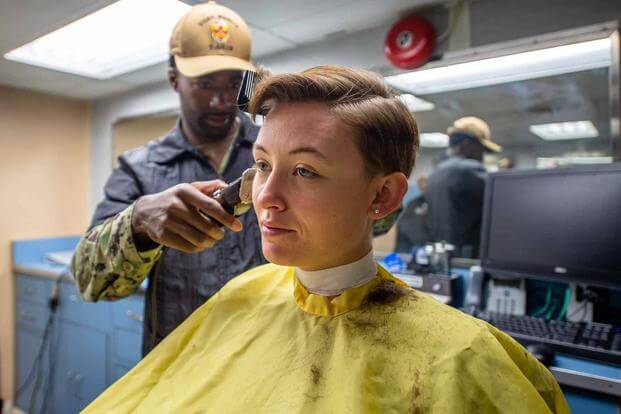The Navy is changing its uniform policy, relaxing some requirements that include an expansion of the allowed hairstyles sailors can have as well as some changes to the rules surrounding the uniforms themselves.
Effective immediately, male sailors can have flat-tops, high and tight, faded and bald hairstyles, the Navy said in an administrative message issued Tuesday. Sideburns also are allowed, though not for bald sailors.
Meanwhile, female sailors will now be allowed to have “very short length hairstyles that show the scalp” to include one shaved side of the head, the message said. Women cannot have “bald hairstyles” unless there’s a medical reason.
Many of the changes come as a result of “sailor feedback during uniform and grooming standards focus and working groups held in the fleet,” the Navy said in a statement.
Rob Carroll, who is in charge of uniform matters on the staff of the chief of naval personnel, specifically said in the statement that the changes to women’s hairstyles were implemented to give “women more options for greater ease on hair care, especially while on deployment when longer styles can be tougher to maintain.”
“Female Sailors have been asking for this flexibility,” he added.
In addition to hairstyles, the new rules make a variety of smaller but notable changes to uniform rules.
Male sailors are now allowed to wear earrings out of uniform on leave or liberty, women can now wear heels up to 3 inches in height in uniform, up from 2 5/8 inches, and rules on eyeglasses and sunglasses colors have been relaxed.
“There are just so many options available today for glasses and we needed to get some standardization of appearance in uniform,” Carroll said.
Sailors “whose legal names contain accents can now have them reflected in name tags, name patches, or name tapes on Navy uniforms.”
The new regulation also lets sailors wear smartwatches and fitness trackers as watches, but the message notes that they "are subject to applicable security regulations," alluding to the fact that many contain GPS and cellular technology.
Though the Navy did not explicitly cite diversity or inclusion as reasons behind some of the changes, Carroll noted that they got “feedback” from sailors on some of these policies during the Navy’s anti-discrimination “Task Force One Navy” listening sessions throughout 2020.
“TF1N did not drive the policy changes, but it can be noted that some of the changes align with the Navy’s Diversity, Equity and Inclusion initiatives,” he added.
The Navy is not the only branch to loosen rules on hair styles in recent months. In January, 2021, the Army began allowing women to sport ponytails and buzzcuts. The Air Force gave their servicemembers permission to wear longer braids and bangs in the same month.
-- Konstantin Toropin can be reached at konstantin.toropin@military.com. Follow him on Twitter @ktoropin.
Related: The Marines Want a Next-Gen Combat Utility Uniform. Here's What Could Change















